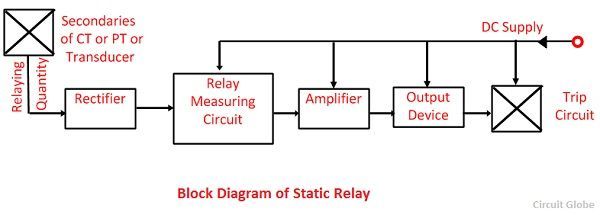Definition: The relay which does not contain any moving parts is known as the static relay. In such type of relays, the output is obtained by the static components like magnetic and electronic circuit etc. The relay which consists static and electromagnetic relay is also called static relay because the static units obtain the response and the electromagnetic relay is only used for switching operation.
The component of the static relay is shown in the figure below. The input of the current transformer is connected to the transmission line, and their output is given to the rectifier. The rectifier was rectifying the input signal and pass it to the relaying measuring unit.
The rectifying measuring unit has the comparators, level detector and the logic circuit. The output signal from relaying unit obtains only when the signal reaches the threshold value. The output of the relaying measuring unit acts as an input to the amplifier.
The amplifier amplifies the signal and gives the output to the output devices. The output device activates the trip coil only when the relay operates. The output is obtained from the output devices only when the measurand has the well-defined value. The output device is activated and gives the tripping command to the trip circuit.
The static relay only gives the response to the electrical signal. The other physical quantities like heat temperature etc. is first converted into the analogue and digital electrical signal and then act as an input for the relay.
Advantages of Static Relay
The following are the benefits of static relays.
- The static relay consumes very less power because of which the burden on the measuring instruments decreases and their accuracy increases.
- The static relay gives the quick response, long life, high reliability and accuracy and it is shockproof.
- The reset time of the relay is very less.
- It does not have any thermal storage problems.
- The relay amplifies the input signal which increases their sensitivity.
- The chance of unwanted tripping is less in this relay.
- The static relay can easily operate in earthquake-prone areas because they have high resistance to shock.
Limitations of Static Relay
- The components used by the static relay are very sensitive to the electrostatic discharges. The electrostatic discharges mean sudden flows of electrons between the charged objects. Thus special maintenance is provided to the components so that it does not affect by the electrostatic discharges.
- The relay is easily affected by the high voltage surges. Thus, precaution should be taken for avoiding the damages through voltage spikes.
- The working of the relay depends on the electrical components.
- The relay has less overloading capacity.
- The static relay is more costly as compared to the electromagnetic relay.
- The construction of the relay is easily affected by the surrounding interference.
For integrated protection and monitoring systems programmable microprocessor controlled static relays are preferred.


Thanks a lot.
very useful information tnq sir
Good sir thanks
Thanks
thanks
Wow, thanks a lot for making my day